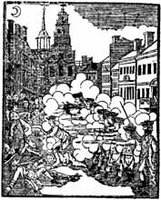“Jealous, very jealous, of the honour of Massachusetts”
The Virginia lawyer and politician William Wirt (1772-1834, shown here courtesy of the Library of Virginia) had two big accomplishments in 1817. First, he finally published Sketches of the Life and Character of Patrick Henry, a biography that he’d been working on for years. Second, he was appointed Attorney General of the United States. He remained in that post for twelve years, through the administrations of James Monroe and John Quincy Adams.
Wirt’s biography of Henry is the earliest source for many anecdotes about the Virginia politician’s life, and for many of his famous quotations, including “Give me liberty or give me death!” Nobody recorded those speeches at the time, the author complained, so he had to do extra work reconstructing them as they ought to have been.
Some of Henry’s contemporaries (and occasional rivals) noticed. Thomas Jefferson, who had been one of Wirt’s sources, said privately that the biography was “a poor book, written in bad taste.” But it was also a successful book, and one of the foundation stones of the literature of the American South.
Up in Massachusetts, John Adams borrowed a copy. On 5 Jan 1818, before he had even finished reading, he sent a letter to Wirt, damning the book with faint praise as “rich entertainment.” He went on:
If I could go back to the age of thirty five, Mr. Wirt, I would endeavour to become your rival; not in elegance of composition, but in a simple narration of facts, supported by records, histories, and testimonies, of irrefragable authority. I would adopt, in all its modesty, your title, “Sketches of the life and writings of James Otis, of Boston.” . . .Wirt replied on 12 January with a complimentary copy for Adams and assurance that he didn’t mean to set off a regional rivalry. In Constructing American Lives: Biography and Culture in Nineteenth-Century America, Scott E. Casper called this “an unconvincing assertion from an author who had asserted the Old Dominion’s preeminence in the Revolution.”
I envy none of the well merited glories of Virginia, or any of her sages or heroes. But, sir, I am jealous, very jealous, of the honour of Massachusetts.
The resistance to the British system, for subjugating the colonies, began in 1760, and in the month of February, 1761, James Otis electrified the town of Boston, the province of Massachusetts bay, and the whole continent, more than Patrick Henry ever did in the whole course of his life. If we must have panegyrics and hyperboles, I must say, that if Mr. Henry was Demosthenes, and Mr. Richard Henry Lee, Cicero, James Otis was Isaiah and Ezekiel United.
Wirt’s book continued to rankle Adams. The fourth Josiah Quincy recalled one visit to the former President’s house in Braintree on 6 Sept 1820 with some men from Virginia:
His visitors asked him his opinion of Patrick Henry, and whether he was not the greatest orator he had ever heard.This wasn’t the first time Adams had grumbled about Virginians saying all their geese are swans, but not seeing Massachusetts credited with coming first in the Revolution really rankled him.
His reply was: “No, gentlemen. Much of Wirt’s life of him is a romance. Why, I have heard that gentleman’s father (pointing to one who was present [probably the third Josiah Quincy, son of the Patriot lawyer]) speak in a strain of eloquence to which Patrick Henry could never pretend. . . . You know Virginian geese are always swans.”
Notwithstanding these remarks, the gentlemen seemed very much pleased with their visit.
TOMORROW: John Adams strikes back.



